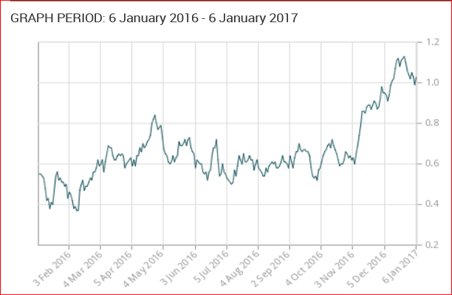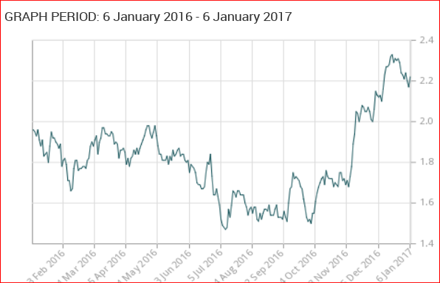A Second Opinion On The Bond Market: Time To Buy Canadian Bonds
As the U.S. bond market surged in yields following the presidential election, Canadian bonds followed in lock step across the yield curve. Spreads retained their recent levels, despite the fact that economic conditions in Canada are markedly different, casting doubt on the wisdom in the sell-off in Canada. Just how pronounced the rise in yields have been is evident in the accompanying charts. On average the bonds in the 3-5 year range moved up from 0.6 per cent to 1.1 and a similar 50-60 bps move occurred in the long bond.
Average Yield of 3-5 year bonds

Average Yield of over 10 years

In its October, 2016 Monetary Policy Report, the Bank of Canada looked at the risks to the Canadian economy, citing the following:
- Measures of economic slack continue to point to ``material excess capacity``;
- CPI measures remain in the `` lower half of the Bank`s inflation-control range`` ( 1-3 per cent );
- Any boost in higher prices dues to the depreciation in the currency is `` more than offset by downward pressures from energy prices and persistent excess capacity``.
- Persistent weakness in the export sector.
In addition, the Bank examined the balance of risks facing the Canadian economy at the time. On the negative side, it noted: the continued weak productivity growth; weak export performance; sluggish business investment; and growing protection sentiment in the United States.On the positive side, it looked to higher U.S. growth and higher oil prices.
In its most recent survey of business intentions,[1] the Bank learned that there has been some increased optimism in the business community. The drag from the oil price collapse of 2014 is dissipating and there are slightly more executives who expect an increase in investments over the next two years. However, the survey reveals that excess capacity continues to weigh heavily and that more than 66 per cent of respondents expect that inflation will be in the 1-2 per cent range over the next two years. Finally, a high percentage of respondents warned that the risks of U.S. protectionism pose considerable risk to the investment outlook. So, while there has been some improvement in corporate sentiment post U.S. election, the underlying issues are still much in front and centre.
What are the implications for bond investors?It can be argued that Canadian bond yields reflect the almost universal sentiment that the United States is entering a period of strong growth and higher inflation. Yet, those expectations are not substantiated by the facts on the ground in Canada. Capacity utilization remains low, unemployment continues to hover around the 7 per cent level and inflation and inflationary expectations are well within the Bank’s acceptable range of 1-3 per cent. A recent survey by Statistics Canada reveals that planned capital expenditures in both the manufacturing and extraction industries are not expected to add much to GDP.
Thus, there are no grounds for Canadian bond yields to surge and remain at this relatively higher plateau. Should the Canadian 10 yr bond retrace its steps back to the level preceding the election, an investor would receive a 4 per cent capital gain. This retrenchment in yields is a plausible outcome given the weak economic conditions at home.
Bond markets can remain cheap in price terms (i.e. higher yields) while the world awaits the Trump administration’s policy moves. However, it is important to bear in mind that Canadian bond yields will, ultimately, reflect domestic conditions which continue to be supportive of lower bond yields.
[1] Bank of Canada, Business Outlook Survey, Winter 2016-17



